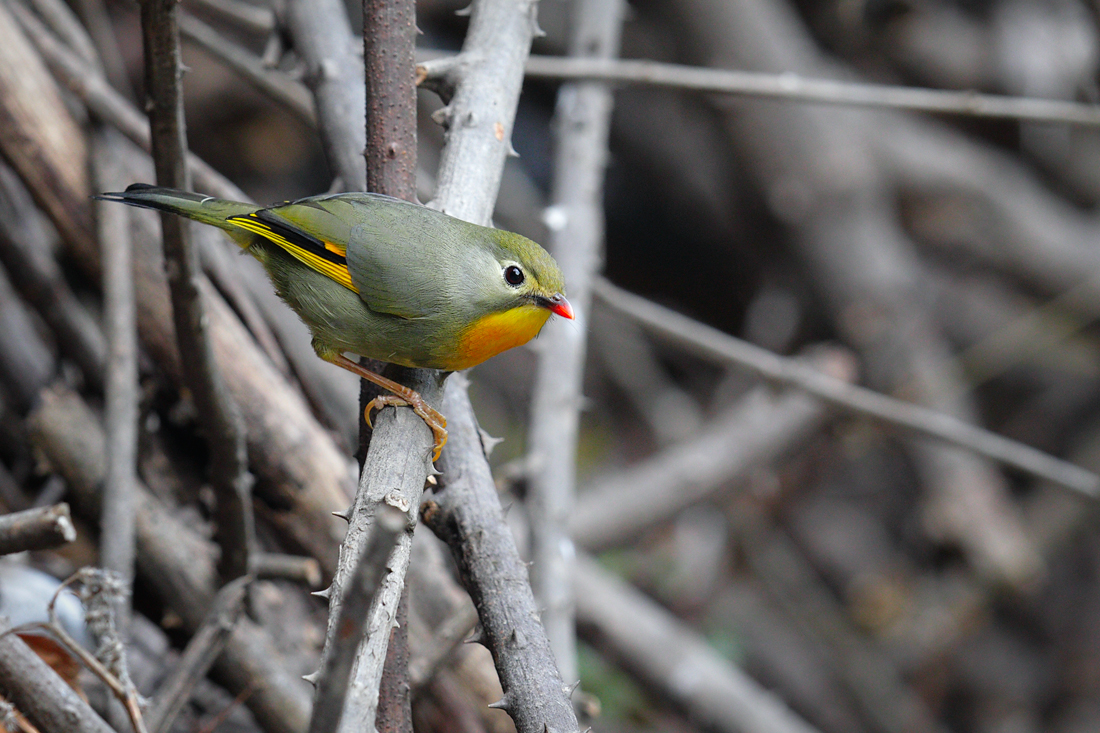| Kingdom: Animalia Phylum: Chordata Class: Aves (Birds) Order: Passeriformes Family: Sylviidae | |
Identification: The Red-billed Leiothrix is a babbler beautifully marked with bright coloring. The adults have bright red bills and a dull yellow ring around their eyes. Their backs are dull olive green and have a bright yellow-orange throat with a yellow chin. They have forked blackish tails. Female Leiothrix are similar to males but with a duller shade. Juveniles have black bills and gray coats. There are two sub-species - the rarer and western L. lutea kumaiensis (red on edge of inner primaries absent), and the eastern and relatively more common L. lutea calipyga (inner primaries edged with red). Distribution: Red-billed Leiothrix are native to Southern Asia ranging from central Himalayas in India and Nepal, eastwards to Burma and Vietnam. Leiothrix prefer to inhabit underbrush at all elevations with a cover of dense vegetation near the ground. These birds are found at elevations 700 m to 2000 m in winters and 1500 m to 2700 m in summers. Flocks of Leiothrix's have been known to fly up to elevations of 4500 m for a short period of time. These birds favor areas with at least 40 inches of rain. Habits: These conspicuous birds often travel in small flocks and are active fliers. In the wild the breeding pairs seem to get along well when overlapping each other's territory. To get around, these birds walk, hop, climb, and also fly. Leiothrix's frequently bathe in shallow pools. In the wild, they are generally monogamous. Calls: The Red-billed Leiothrix is also known for it's vocalizations. It sings a loud, melodious warbling song somewhat similar to that of Red-whiskered Bulbul. While feeding it utters a clear 'pe pe pe pa' or 'pu pu pu pu'. Food: Fruits and seeds compromise the majority of their diet with the remainder made up of invertebrates. Their diet also includes: larval and adult butterflies, moths, millipedes, and spiders. They have been known to eat mealworms and mollusk. These birds often drink from pools of water on fallen leaves. Breeding: Singing is most constant during the breeding season. Nesting usually occurs in underbrush at all elevations. The nest is built shaped like a cup and consists of leaves (including bamboo), moss, and lichen, lined with fine threads of fungal substance. The nest is placed on a horizontally forked branch of may also be bound to stems or twigs. Female Leiothrix usually lay three to four eggs. The average size of an egg is around 15.4 x 20.4mm. These eggs are pale blue and contain reddish-brown spots. Since the nesting sites are so low to the ground, they are highly vulnerable to predators, especially rats. Adults may distract predators away from the nest by running and calling on the ground. Incubation takes approximately 14 days. Newly hatched nestling have a bright reddish apricot skin. Both parents take turns feeding the young. Babies are mostly fed insects and sometimes fruits. | |
 birding.in
birding.in
| Birds | Bird Diagram | Ornithology | Indian Sites | Bird Watching | Migration | North India | Birds of India | Haryana |
All rights reserved. Copyright © 2005-2013 Birds and birding in India. Disclaimer
website: Free Java Guide & Tutorials
